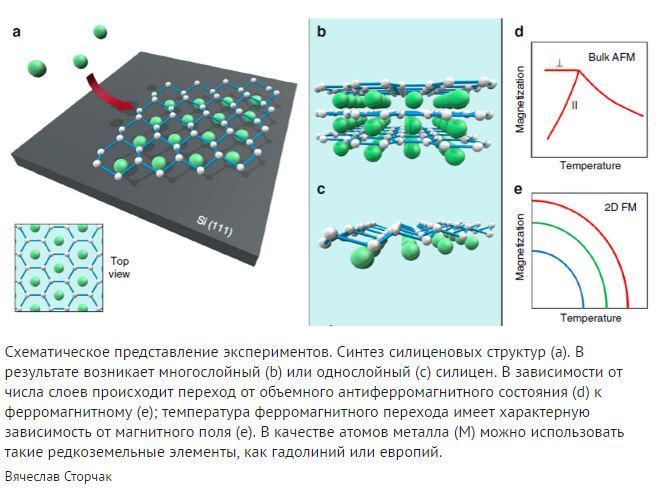From the silicon analogue of graphene it was possible to create a two-dimensional magnet
Russian physicists have received a new class of two-dimensional silicon magnets – spintronic materials that can form the basis of breakthrough technologies of storage and transmission of information. The research is supported by a grant from the Russian Science Foundation (RPF). The findings are published in the journal Nature Communications.
Unlike conventional electronics, spintronics uses not only the charge of the electron, but also its spin (one of its quantum properties) to store and transmit information. Working with spin can lead to the creation of fundamentally new transistors, elements of computer memory, logical elements.
“The prospect of creating ultra-compact spintronics – an alternative to modern electronics – leads to the search for magnetism in low-size systems. We have discovered a whole class of two-dimensional magnets – new spintronic materials,” said the study’s author, Dr. Vyacheslav Storchak.
Traditional spintronics use conventional (i.e. three-dimensional) magnetic materials to control the electron’s spin. At the same time, the prospect of creating ultracompact spintronics gives a significant boost to the research of magnetism in low-size systems. In recent years, science has made significant progress in the creation of 2D magnets due to external factors such as defects or the effect of proximity. 2D materials with inherent magnetism were unknown until the recent discovery of ferromagnetism in several monolayers of Van der Waals crystals based on chromium.
In order to detect magnetism at this level, scientists used optical methods with exceptionally high sensitivity. After this discovery, scientists began to look for 2D magnets with strong ferromagnetism, which can measure standard magnetometers, with concomitant beneficial properties. It is especially important that these magnets are compatible with modern semiconductor technology. Recently, Russian physicists managed to discover a new class of 2D materials with ferromagnetic properties based on silicen.
Silizen is the silicon analogue of graphene. In theory, it should be an ideal platform for spin phenomena and spintronic applications. In graphene and silicesen atoms are stacked in one layer of hexagons, resembling honeycomb, but if the graphene this layer is flat, the hexagons silicesen “corrugated.”
The silicene monolayer reacts strongly with the surrounding materials, so it is not easy to experiment with it. Physicists have developed a technique that allows to synthesize layers of silicene of different thickness, paired with 2D lattice rare earth elements. Alternating 2D layers of siliczen and rare earth metal atoms were synthesized using molecular-beam epitaxy – the build-up of one crystalline monolayer on top of another in an ultra-high vacuum. Metal atoms were directed to a heated silicon surface. In order to avoid the interaction of silitzene with air in the future, the resulting material was protected by a thin layer of silicon oxide. This approach can also be used to synthesize monolayers of other analogues of graphene, such as the Germanen, consisting of germanium atoms.

The main result of the work is the discovery that layered structures formed by siliceene, paired with 2D lattice rare earth elements, demonstrate strong 2D ferromagneticism within the limit of one or more monolayers. Unlike chromium-based materials, ferromagnetism in silicene materials arises from the anti-ferromagnetism of the parent’s 3D compound. Open rare earth magnets exhibit other distinctive features: much greater sensitivity of the temperature of transition to weak magnetic fields (characteristic of 2D ferromagnestism) and a significant magnetic moment, allowing the study with the help of conventional magnetometers.
“The discovery of the first class of 2D magnets compatible with silicon technology can have a significant impact on various fields of science and technology,” summed up Vyacheslav Storchak. “The published results may serve as a new platform for the study of two-dimensional phenomena in layered structures. This is one of the very few studies of silicezen materials where it was possible to go beyond structural research, and perhaps the first, where it was possible to experimentally demonstrate the defining role of the silice lattice. The structure of silice magnets is great for creating different silicon heterostructures that can be used in the creation of new electronics elements
.Source:indicator.ru